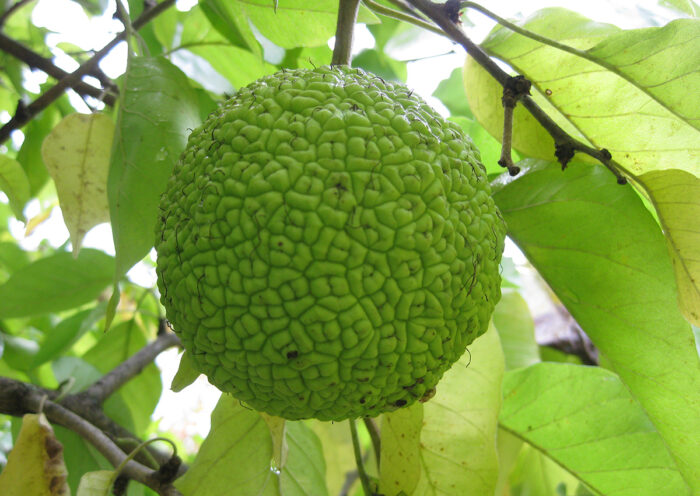
In October and November, apple-green, grapefruit-size fruits of female Osage orange trees (Maclura pomifera, Zones 4–9) fall from their canopies and hit the ground with a hearty thump. This North American native species is part of the mulberry family and has a long history of use throughout the Midwest for its wood, and more recently, for its extreme tolerance to urban conditions. It’s worth considering the next time you are planning to plant a large landscape tree.
Originally native to the Southern Plains, Osage orange can now be found in all 48 contiguous states
Osage orange is named after the Native American Osage tribe that traditionally lived in much of the Central and Southern Plains and used the strong and sturdy wood of the tree to make bows (which explains the origin of another common name of this tree, bow wood). This species is native to river valleys and rich bottomlands in Arkansas, Oklahoma, Texas, and Louisiana.
Now found in all 48 contiguous states, it received broad promotion and use during Franklin D. Roosevelt’s “Great Plains Shelterbelt” WPA (Work Progress Administration) program for erosion control and as a barrier hedge that was “horse high, bull-strong, and pig tight.” Thorny branches, quick growth, and a “thicketing” tendency allowed for the broad availability, use, and distribution of this species. Thousands of miles of Osage orange hedgerows were planted in the 1930s. However, the mass production and availability of barbed wire became the more popular way of separating and securing space. Osage orange has also been used for soil stabilization projects and strip-mine reclamation.
This large tree produces its interesting fruit after 10 years of age
Reaching heights of 35 to 60 feet tall and just as wide, Osage orange features ovate, shiny green leaves that get a decent yellow fall color. The orange-brown bark becomes showier with age, and the durable, close-grained wood has extreme rot resistance, which is good for the health of the tree and those who wish to use the tree for wood. Additionally, a yellow-orange dye can be extracted from the wood, and it has the highest heating value of any North American wood, burning very hot for a long time.
The fruits, typically produced after 10 years of age, grow to about 5 inches across and are quite unique and interesting. Female trees need a male pollinator to produce fruit. Each fruit is actually a dense cluster of hundreds of smaller fruits that have merged—or to use the botanical term, it’s a “syncarp of drupes.” Milky latex oozes from damaged or cut fruits. While not poisonous to humans or livestock, the fruit is not eaten by many creatures, although deer and squirrels will nibble on the inner seeds. They are also inedible for humans.
The fruits were long put in closets, drawers, and cabinets for their insect-repelling properties, which have since been found to be exaggerated. However, recent research by the USDA has found that the chemical elemol, which can be extracted from the fruits, shows excellent promise as a mosquito repellent, with comparable ability to DEET.
Osage orange thrives in tough conditions in full sun
While preferring moist sites, Osage orange tolerates both dry and wet conditions as well as extreme drought, clay, and air pollution. Full-sun locations are preferred, although partial sun is acceptable. Keep in mind that the USDA now indicates that Osage orange has the potential to invade areas abused by poor management or overgrazing. Becoming weedy and aggressive in some regions or habitats, it may displace desirable vegetation. Proper management in these situations is key to prevent this plant from spreading in an undesirable manner.
This tree is gaining more prominence in urban settings with the promotion of male (hence fruitless) and thornless selections such as ‘White Shield, ‘Wichita’, and ‘Denmark’. These and other selections are becoming more available for use as street trees, in urban parks, and other tough locations. On the other hand, gardeners who like the fruit might want to check out ‘Cannonball’, which has fruits up to twice the size of the average fruit. Osage orange has a long and rich history of use and seems to have a bright and promising future as well.
—Mark Dwyer is the garden manager for the Edgerton Hospital Healing Garden in Edgerton, Wisconsin, and he operates Landscape Prescriptions by MD.
Photos: Mark Dwyer
Fine Gardening Recommended Products

DeWalt Variable-Speed Cordless Reciprocating Saw with 6-Piece Saw Blade Set

DeWalt Variable-Speed Cordless Reciprocating Saw





















Comments
Log in or create an account to post a comment.
Sign up Log in